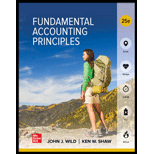
1.
Concept Introduction:
Activity-based costing: Activity-based costing is one of the cost allocation methods where
The activity rates for each activity.
2.
Concept Introduction:
Activity-based costing: Activity-based costing is one of the cost allocation methods where overhead costs are allocated based on activity usage. It can be determined by using multiplying activity rate and activity usage. Activities can be classified as production, setups, design, and factory services.
The overhead costs per model.
3.
Concept Introduction:
Activity-based costing: Activity-based costing is one of the cost allocation methods where overhead costs are allocated based on activity usage. It can be determined by using multiplying activity rate and activity usage. Activities can be classified as production, setups, design, and factory services.
The product costs per unit for each model.
4.
Concept Introduction:
Activity-based costing: Activity-based costing is one of the cost allocation methods where overhead costs are allocated based on activity usage. It can be determined by using multiplying activity rate and activity usage. Activities can be classified as production, setups, design, and factory services.
The difference between the selling price and product cost for each model.
Want to see the full answer?
Check out a sample textbook solution
Chapter C Solutions
FUND.ACCT.PRIN.
- ABC Company has the following financial data: Cash: $30,000Accounts Receivable: $50,000Inventory: $40,000Accounts Payable: $25,000Short-term Debt: $15,000Other Current Liabilities: $20,000Calculate the following: Current AssetsCurrent LiabilitiesCurrent Ratioarrow_forwardAccurate Answerarrow_forwardGeneral accountingarrow_forward
- I need help with this solution and general accounting questionarrow_forwardA company has the following data: Sales: $600,000 Cost of Goods Sold: $350,000 Operating Expenses: $100,000 Interest Expense: $20,000 Tax Expense: $30,000 What is the net income? . explainarrow_forwardCan you demonstrate the accurate method for solving this financial accounting question?arrow_forward
- A company has the following data: Sales: $600,000 Cost of Goods Sold: $350,000 Operating Expenses: $100,000 Interest Expense: $20,000 Tax Expense: $30,000 What is the net income?arrow_forwardCan you help me solve this general accounting problem using the correct accounting process?arrow_forwardPlease given correct answer for General accounting question I need step by step explanationarrow_forward
 Principles of Cost AccountingAccountingISBN:9781305087408Author:Edward J. Vanderbeck, Maria R. MitchellPublisher:Cengage Learning
Principles of Cost AccountingAccountingISBN:9781305087408Author:Edward J. Vanderbeck, Maria R. MitchellPublisher:Cengage Learning Cornerstones of Cost Management (Cornerstones Ser...AccountingISBN:9781305970663Author:Don R. Hansen, Maryanne M. MowenPublisher:Cengage LearningPrinciples of Accounting Volume 2AccountingISBN:9781947172609Author:OpenStaxPublisher:OpenStax College
Cornerstones of Cost Management (Cornerstones Ser...AccountingISBN:9781305970663Author:Don R. Hansen, Maryanne M. MowenPublisher:Cengage LearningPrinciples of Accounting Volume 2AccountingISBN:9781947172609Author:OpenStaxPublisher:OpenStax College Excel Applications for Accounting PrinciplesAccountingISBN:9781111581565Author:Gaylord N. SmithPublisher:Cengage Learning
Excel Applications for Accounting PrinciplesAccountingISBN:9781111581565Author:Gaylord N. SmithPublisher:Cengage Learning Essentials of Business Analytics (MindTap Course ...StatisticsISBN:9781305627734Author:Jeffrey D. Camm, James J. Cochran, Michael J. Fry, Jeffrey W. Ohlmann, David R. AndersonPublisher:Cengage Learning
Essentials of Business Analytics (MindTap Course ...StatisticsISBN:9781305627734Author:Jeffrey D. Camm, James J. Cochran, Michael J. Fry, Jeffrey W. Ohlmann, David R. AndersonPublisher:Cengage Learning Managerial Accounting: The Cornerstone of Busines...AccountingISBN:9781337115773Author:Maryanne M. Mowen, Don R. Hansen, Dan L. HeitgerPublisher:Cengage Learning
Managerial Accounting: The Cornerstone of Busines...AccountingISBN:9781337115773Author:Maryanne M. Mowen, Don R. Hansen, Dan L. HeitgerPublisher:Cengage Learning





